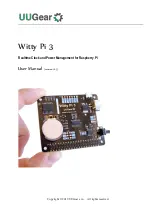
Operation of the GPIB
Appendix D
GPIB-232CT User Manual
D-2
© National Instruments Corp.
Devices can be Listeners, Talkers, and/or Controllers. A digital voltmeter,
for example, is a Talker when sending measurements and is a Listener
when receiving programming messages.
The GPIB is a bus like an ordinary computer bus, except that the computer
has its circuit cards interconnected via a backplane bus, whereas the GPIB
has stand-alone devices interconnected via a cable bus.
The role of the GPIB Controller can also be compared to the role of the
CPU of a computer, but a better analogy is to the switching center of a city
telephone system.
The switching center (Controller) monitors the communications network
(GPIB). When the center (Controller) notices that a party (device) wants to
make a call (send a data message), it connects the caller (Talker) to the
receiver (Listener).
The Controller addresses a Talker and a Listener before the Talker can send
its message to the Listener. After the message is transmitted, the Controller
can unaddress both devices.
Some bus configurations do not require a Controller. For example, one
device can always be a Talker (called a Talk-only device) and there can be
one or more Listen-only devices.
A Controller is necessary when the active or addressed Talker or Listener
must be changed. The Controller function is usually handled by a
computer.
In S mode, the GPIB-232CT peforms the following three roles:
•
Controller - to manage the GPIB
•
Talker - to send data to an attached GPIB device
•
Listener - to receive data from an attached GPIB device
In G mode, the GPIB-232CT is a GPIB device. It performs only the
following two roles:
•
Talker - to send data to the GPIB host
•
Listener - to receive data from the GPIB host
















































